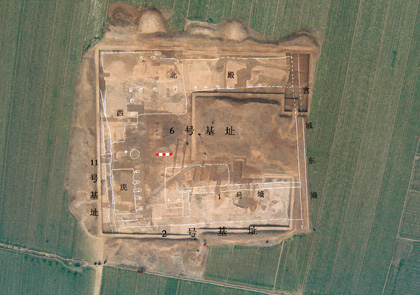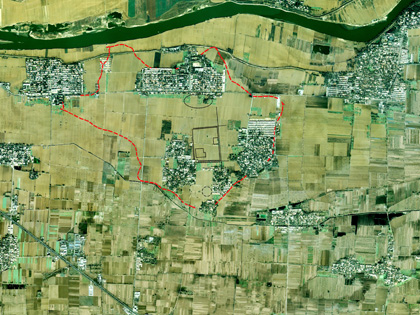“Archaeological China : An Exhibition of Achievements for the 60th Anniversary of the Chinese Academy of Social Sciences’ Institute of Archaeology” Opened at the Capital Museum
The grand opening of the exhibition “Archaeological China” was held at the Capital Museum in Beijing on July 29th 2010. The exhibition was jointly organized by the Chinese Academy of Social Sciences’ Institute of Archaeology and the Capital Museum and is part of the programme of events being held to mark the 60th anniversary of the founding of the CASS Institute of Archaeology. The exhibition is a showcase of some of the most important archaeological discoveries of the past sixty years and is a tribute to the painstaking efforts by renowned scholars, such as the late Professor Xia Nai, and the outstanding achievements of hundreds of archaeologists across four generations.

Archaeology had a weak basis in China prior to the foundation of the Institute of Archaeology. In the first thirty years after the founding of the Institute of Archaeology, the Institute’s efforts were focused on a number of field projects, which included :
Field surveys of the prehistoric cultures which had inhabited the Central Plains and the surrounding areas and on the large-scale excavations of archaeological sites such as Banpo and Miaodigou, which allowed archaeologists to gradually establish a timeline for the development of Neolithic cultures across China;
The development of research on Xia culture and the search for the origins of the Shang Dynasty;
Excavations at Shang and Zhou imperial cities such as the Yinxu ruins in Anyang, the Chang’an and Fenghao ruins in modern-day Xi’an, and the Eastern Zhou capital Wangcheng in Luoyang, which have helped archaeologists establish a chronology for the Xia, Shang and Zhou Dynasties, and;
The survey and excavation of the Han and Tang capital cities, Chang’an and Luoyang, and the Yuan Dynasty capital, Dadu , which have allowed archaeologists to study the evolving principles of urban design across successive dynasties.

The research conducted during these excavations made a substantial contribution to the development of Chinese archaeology as an academic discipline and projects such as the ones mentioned above form the backbone of field archaeology in China.
Since the 1970s, archaeological fieldwork projects have been conducted in each of China’s 32 provinces, autonomous regions, municipalities and special administrative regions. These projects have yielded stunning results and led to a bewildering number of archaeological discoveries. Projects conducted in the last few decades include :
Research on the Neolithic Revolution in northern and southern China;
The complete excavation of the sites of primitive settlements and burial grounds, such as those at Liuwan in Qinghai Province, Wangyin in Shandong Province, Xinglongwa in Inner Mongolia, and the Yuchisi in Anhui Province;
The exploration of Xia, Shang and Zhou archaeological sites, such as the newly-discovered Shang city ruins at Yanshi and Huanbei; the excavations of the Erlitou, Yinxu and Fenghao sites; new breakthrough discoveries at the cemeteries at the Liulihe site in Beijing, Qianzhangda in Tengzhou and Dadianzi in Inner Mongolia; and extensive research on pre-Zhou cultures across China;
The survey and excavation of Han, Tang, Song and Yuan-era sites, such as the Cao Wei - Northern Qi city at Yecheng, the Tang - Song city at Yangzhou, and the Southern Song city of Lin’an;
The exploration of several imperial mausoleums and cemeteries and the excavation of a number of porcelain kilns.
The “Archaeological China” exhibition is divided into eighteen main thematic areas, including : A Witness to Tremendous Change - The transition from the Palaeolithic to the Neolithic age; Feasts of Pork and Millet - The rise and development of agriculture and animal husbandry in prehistoric China; Changing Homes - The rise and spread of prehistoric settlements; The Dawn of Civilization - The course of civilization and the unification of a pluralistic China; The Rise of Dynastic China; The Splendour of the Shang Dynasty; The Great Achievements of Rites and Music; The Majesty of the Imperial Capital Cities - The imperial capital cities of China’s feudal dynasties; Tombs of the Underworld - The tombs and mausoleums of the ancient Chinese emperors; Kilns and Furnaces - The production of porcelain; The Flourishing of Buddhism; The Western Regions; The Power of Science and Technology; Moulding Metals and Fashioning Clay - Bronze production techniques of the Shang and Zhou Dynasties; Turning the Ordinary into the Extraordinary; and Out of the Ivory Tower.

Over 400 precious cultural relics excavated from more than 60 ancient settlements, imperial city ruins, Buddhist temples and imperial tombs will be on display along with numerous photographs, text commentaries and a selection of documentary films on the excavation of a number of archaeological sites across China. The various exhibits will allow visitors to experience the sense of achievement of the past sixty years and indulge their interests in the different aspects of archaeological research, while the exhibition as a whole will help illustrate the glorious cultural legacy that the Chinese people have inherited from their forefathers. With its novel thematic approach, rich content and diverse selection of exquisite cultural artifacts, the “Archaeological China” exhibition is second to none and is the largest exhibition devoted exclusively to archaeology that has ever been held in China.
The most important feature of the “Archaeological China” exhibition is the way in which it encompasses a variety of key topics in archaeological research and the wealth of knowledge at hand. The exhibits touch upon some of the major issues in Chinese archaeology, such as the characteristics of cultural change around 10,000 BP, the origins of agriculture and animal husbandry, the dawn of Chinese civilization and the rise of royal dynasties, and the evolution of the imperial capital throughout China’s dynastic history.
The exhibition also focuses on the latest developments in archaeological research as well as topics which may be of interest to the general public : the vestiges of prehistoric earthquakes; how the ancients buried their dead; the search for the cities of the mythical pre-Xia rulers Yao and Shun; the discovery and decipherment of the Shang Dynasty’s oracle bone script; the bronze casting techniques of China’s ancient civilizations; the whereabouts of the palace foundations of the Qin Dynasty’s Epang Palace; the profound influence that Cao Cao’s city, Ye, had on the development of other imperial capital cities in ancient China; ancient craniotomies; and how archaeologists are able to analyze eating patterns and diets in ancient times.

In addition, the exhibition highlights the important role that scientific techniques and equipment plays in modern archaeological research and presents an overview of the applied uses of GPS satellites, digital photogrammetry, 3D laser scanners, remote sensing and ground-penetrating radar in archaeology. Information on spatial information technologies, archaeological surveys, dating methods, environmental archaeology, physical anthropology, zooarchaeology, archaeobotany, chemical and structural analysis, dendrochronological dating of trees and timber, and isotope analysis will be available at the exhibition so as to give visitors an insight into some of the latest trends in archaeological research. .
Numerous precious cultural artifacts will be on display during the exhibition. The majority of the items on display are exquisite relics which were unearthed during archaeological digs conducted by the Institute of Archaeology and many of these will be on public display for the first time since their discovery. These include a variety of bronzes, jade pieces, porcelain, pottery figurines, and gold and silver artifacts, such as 15,000-year-old ground stone spades and arrowheads excavated in northern China, 9,000-year-old rice grains from the Qiantang River basin, a sacrifical vessel with a standing bird figurine on the top excavated at the Yuchisi site in Anhui which date back almost 5,000 years, a 4,000-year-old vessel decorated with a red brush-written “wen” character and tiles discovered at the Taosi site, a plate with a black painted snake-like coiled dragon, exquisite Chinese leopard bronze figurines inlaid with gold and rubies which date back to the Han Dynasty, and human-faced tiles dating back to the Northern Dynasties. A number of documentary films on Chinese archaeology will also make their public début during the exhibition. These include a tribute to the late Professor Xia Nai, an analysis of the Taosi observatory and the slits in its observation platform, and footage of the excavations of Tomb No.54 at Yinxu and the Longquan kiln.
In addition, a series of academic and informative lectures by experts from the CASS Institute of Archaeology will be held during the exhibition period.
“Archaeological China” is not merely a showcase of the CASS Institute of Archaeology’s achievements in the sixty years since its foundation; it is also the first time that such an exhibition has been open to, and aimed at, the general public. Thanks to the painstaking efforts of the Capital Museum’s staff, the exhibition embodies the enduring dialogue between the past and the present and has an air of timelessness about it. Visitors to the exhibition will no doubt find themselves completely immersed in China’s archaeological past and its ancient and resplendent cultural history. (Translated by Kelly McGuire)

